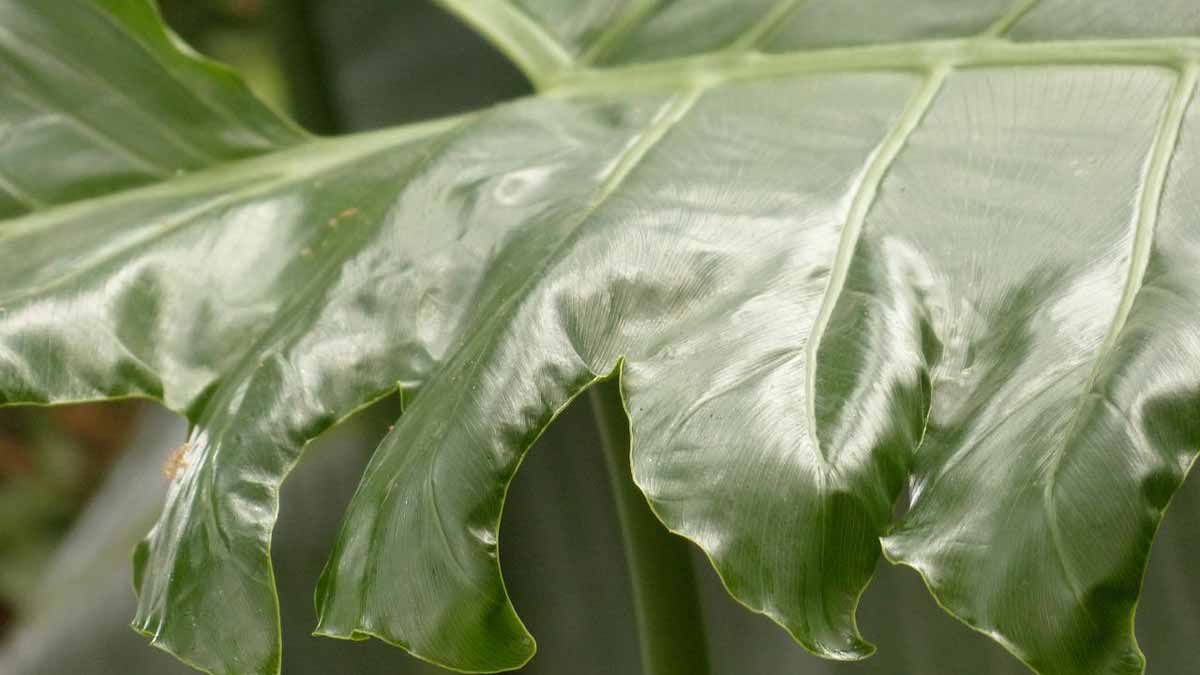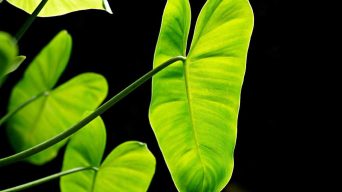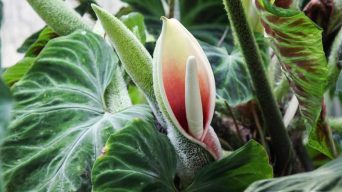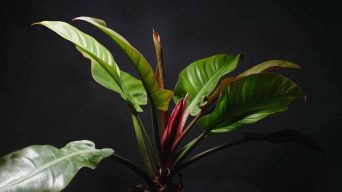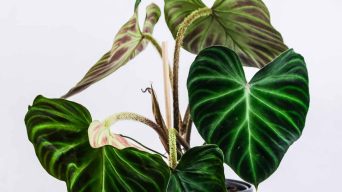Philodendron plants are popular houseplants because they are easy to care for and can thrive in various indoor conditions.
However, even the most experienced Philodendron growers may occasionally experience plant issues.
One common problem is Philodendron leaves curling.
Why Are My Philodendron Leaves Curling and How Can You Fix It?
There are several reasons why Philodendron leaves may curl.
Most often, the problem is due to environmental factors, such as too much or too little light, excessive heat or cold, or insufficient humidity.
Sometimes, leaf curling can also be a sign of a nutrient deficiency or pests.
Luckily, Philodendron leaf curling is usually easy to fix.
In most cases, simply adjusting the environmental conditions or providing the plant with additional nutrients will cause the leaves to uncurl and return to normal.
Here are the most common reasons for Philodendron leaves curling and how to fix them:
1. Underwatering
Philodendron leaves will naturally curl inward when the plant is not getting enough water.
The Philodendron leaves may turn brown and crispy if the plant is allowed to go too long without water.
Philodendron plants are native to tropical regions and prefer high humidity.
Then need to be watered at least once a week, and more often in hot weather.
How To Fix It
The best way to fix underwatering is to give your plant a good watering.
Be sure to water deeply until water flows out of the drainage holes at the bottom of the pot.
Allow the soil to dry out somewhat between waterings.
If the leaves are already crispy, you can try giving the plant a very light misting with water to help rehydrate the leaves.
2. Overwatering
Philodendron plants are just as susceptible to overwatering as they are to underwatering.
If you notice your plant’s leaves are wilting, discolored, and drooping, it’s likely a sign of overwatering.
When a plant is overwatered, the roots cannot get the oxygen they need to function correctly.
This causes philodendron plants to develop root rot, which can eventually kill the plant.
Overwatering usually occurs when the plant is kept in too much moisture, such as in a humid environment or if the potting soil mix doesn’t drain well.
How To Fix It
If you think your plant is being overwatered, the first step is to allow the soil to dry out completely.
You can then start watering your plant less frequently, ensuring to only water it when the top inch of soil is dry.
It’s also a good idea to repot your plant in a fresh potting mix with better drainage.
To help prevent overwatering in the future, make sure to use a pot with drainage holes and avoid getting water on the leaves of the plant.
3. Too Much Sunlight
If your Philodendron plant has curled leaves, it could be a sign that it’s getting too much sunlight.
While Philodendrons can tolerate bright indirect light, they can’t handle too much direct sunlight.
When exposed to direct sun, the plant leaves will start to curl up as a way to protect themselves from the harsh rays.
The philodendron leaves may also start to sunburn and turn brown or black.
If your plant is in a spot that gets direct sunlight for more than a couple of hours a day, move it to a brighter place that doesn’t get direct sunlight.
How To Fix It
The best way to fix this problem is to move your plant to a spot that gets bright indirect light.
If you can’t move your plant, try covering the windows with sheer curtains or blinds to filter out some of the sunlight.
You could also try moving your plant to a different room in your house.
An east- or west-facing window is a good spot for a Philodendron.
This way, the plant will get plenty of light without being in direct sunlight.
4. Heat Stress
Another reason why your Philodendron’s leaves might be curling is because of heat stress.
Philodendrons are tropical plants, so they like warm temperatures.
However, if the temperature gets too hot, the leaves will start curling to prevent the plant from losing too much water.
Philodendrons thrive in temperatures between 65 and 80 degrees Fahrenheit.
Anything above that, the leaves will start to suffer.
How To Fix It
If you think heat stress is why your Philodendron has curling leaves, there are a few things you can do to fix it.
First, ensure the plant is in a room that isn’t too hot.
You might need to move it to a different location or adjust the thermostat.
Second, increase the humidity around the plant.
You can do this by misting the leaves with water or placing the pot on a tray of pebbles and water.
Third, make sure the plant is getting enough water.
When the soil is dry, water the plant thoroughly.
5. Cold Temperatures
Like too much heat can stress a Philodendron plant, so can cold temperatures.
If the leaves of your Philodendron plant are curling, it may be a sign that the plant is too cold.
One way to tell if your plant is too cold is to feel the leaves. The plant is likely too cold if they feel cool or slightly brittle to the touch.
Another way to tell if the plant is too cold is to check the stems. The plant is likely too cold if they are a deep red or purple color.
How To Fix It
If you think your Philodendron plant is too cold, there are a few things you can do to fix the problem.
First, you can try moving the plant to a warmer location. If the plant is near a window, try moving it away from the window.
You can also try using a space heater to warm up the plant’s room.
If you live in an area that gets cold at night, you can try using a grow light to keep the plant warm.
You can also try covering the plant with a blanket or sheet at night to help keep it warm.

6. Pests
If your Philodendron’s leaves are curling, it could indicate that the plant has pests.
Several pests can attack a Philodendron plant, including aphids, mealybugs, spider mites, and scale.
- Aphids are small, pear-shaped insects of various colors, including green, black, brown, or yellow. They tend to congregate on the undersides of leaves and new growth.
- Mealybugs are small, white, fuzzy insects that suck the sap out of plants. They can cause leaf curling, wilting, and yellowing.
- Spider mites are tiny spider-like creatures that spin webs on the undersides of leaves. They cause curling leaves and turn yellow or brown.
- Scale insects, which are diminutive insects characterized by their tough exoskeletons, feed on plant sap and may lead to the yellowing and wilting of Philodendron leaves.
If you think your Philodendron has pests, check the undersides of the leaves for signs of insects or webbing.
You can also look for small bumps on the leaves or stems, which could be eggs.
How To Fix It
To get rid of pests, try spraying the plant with water or using a cotton swab dipped in rubbing alcohol to remove them.
You can also use insecticidal soap or neem oil, which are safe for plants.
Treat the plant every few days until the pests are gone.
If the infestation is severe, you may need to discard the plant.
7. Nutrient Deficiency
If your Philodendron’s leaves are curling, it could be a sign that the plant is deficient in nutrients.
Philodendrons need nutrients such as nitrogen, phosphorus, and potassium to thrive.
They also need micronutrients such as iron, magnesium, and manganese.
A deficiency in any of these nutrients can cause Philodendron curling leaves.
How To Fix It
To fix a nutrient deficiency, you can fertilize the plant with a balanced fertilizer.
Fertilize the plant every few weeks during the growing season. Avoid fertilizing during the winter, as the plant will be dormant.
You can also add compost or manure to the soil to help improve its nutrient content.
Ensure you water the plant regularly so the roots can absorb the nutrients.
If the deficiency is severe, you may need to replace the soil.
Over time, the soil will become depleted of nutrients and will need to be replaced.
8. Transplant Shock
If your Philodendron’s leaves are curling, it could signify transplant shock.
Transplant shock occurs when a plant is moved from one location to another and doesn’t have time to adjust to the new environment.
The plant’s roots are disturbed, and the plant doesn’t have access to the same amount of water or nutrients.
The plant may go into survival mode, stop growing, and cause the leaves to curl and turn yellow or brown.
How To Fix It
To fix transplant shock, you must give the plant time to adjust to its new environment.
Ensure the plant is in a location where it will get the same amount of sunlight and water as it did in its previous place.
Do not fertilize the plant for the first month after transplanting.
After that, you can fertilize the plant every few weeks during the growing season.
You can add compost or manure to the soil to help the plant adjust to its new environment.
9. Compacted Soil
If your Philodendron’s leaves are curling, it could indicate that the soil is too compacted.
Compacted soil doesn’t allow air or water to penetrate, which can cause the plant’s roots to suffocate.
The plant cannot absorb essential nutrients and water, resulting in its leaves curling and changing color to yellow or brown.
How To Fix It
To fix compacted soil, you need to loosen it so air and water can penetrate.
You can do this by adding compost or manure to the soil.
You can also use a garden fork or tiller to loosen up the soil.
Do this carefully so you don’t damage the plant’s roots.
10. Low Humidity
Philodendron plants are native to the rainforests of South America, so they’re used to warm temperatures and high humidity.
If the air in your home is too dry, it can cause your Philodendron’s leaves to curl.
When the air is too dry, the leaves will start to curl in an effort to prevent moisture loss.
They may also turn brown and crispy.
How To Fix It
You can mist the plant with water or use a humidifier to fix low humidity.
You can also place the plant on a pebble tray.
A pebble tray is a tray filled with pebbles and water. The water will evaporate and increase the humidity around the plant.
Make sure you don’t place the plant too close to the humidifier, or it will cause the leaves to curl.
You can also group plants together to increase the humidity around them.
When plants are grouped, they release moisture into the air, which increases the humidity.
How To Prevent Philodendron Leaves From Curling
To prevent Philodendron leaves from curling, you must provide the plant with the proper environment.
Here are some tips:
- Place the plant in an area where it will get indirect sunlight.
- Water the plant when the soil is dry to the touch.
- Fertilize the plant every few weeks during the growing season.
- Avoid fertilizing during the winter.
- Make sure the plant has good drainage.
- Trim off any yellow or brown leaves.
- Keep the plant away from drafts and heat sources.
- Humidity is essential for Philodendron plants, so mist the leaves regularly or place the plant on a pebble tray.
- Check for pests and diseases regularly.
If you follow these tips, your Philodendron plant should stay healthy, and the leaves will not curl.
Final Thoughts
Philodendron care is not difficult, but there are a few things to remember.
You can prevent the leaves from curling by providing the plant with the proper environment and care.
Check for common problems such as underwatering, sunburn, or pests if the leaves start to curl.
With a bit of care, your Philodendron plant will thrive.

